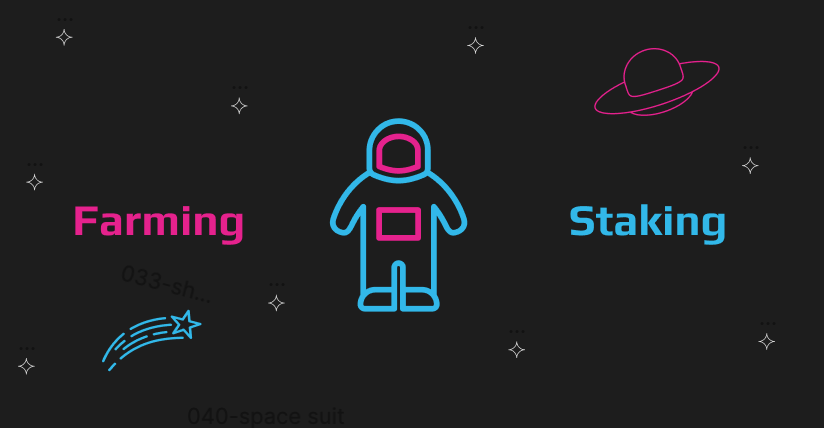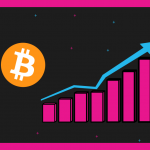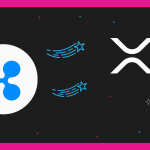With the massive expansion of cryptocurrency over the last few years, protocols that earn passive income have come into the spotlight. Staking and farming are two of the most popular protocols. The main difference between Staking and Farming is the act it’s playing on the blockchain. Staking is the simpler act of locking X cryptocurrency up for Y period of time in order to earn rewards, such as network fees. On the other hand, farming is a more complex strategy-based method where farmers utilize the best liquidity pools in decentralized finance to maximize returns. So, crypto farming vs staking? Let’s learn the difference!

What is Crypto Staking?
Staking is the act of locking up cryptocurrency for a defined or undefined period of time to receive rewards. Staked cryptocurrency is typical for the Proof of Stake consensus mechanism that many large blockchains use today, and is the backbone for validating and securing each block on the network.
Usually, staked cryptocurrency will be locked up with the validator of your choice. Your staked cryptocurrency then represents a certain percentage of the validators pool. If you have a staked amount equal to 7% of the pool, you will receive 7% of the rewards.
The rewards from staking are based on network fees, but each platform can offer different benefits and APY depending on their goal. It is now possible to stake cryptocurrency on centralized exchanges.

How Does Crypto Staking Work?
Cryptocurrency staking is part of a complex Proof of Stake mechanism, where validators are randomly chosen, based on certain metrics such as tokens staked, to validate the upcoming block. However, becoming a validator often requires a large amount of liquidity upfront in the network’s native token.
Ethereum validators for example are required to lock up 32 Ethereum to become a validator, which is over $90,000. For this reason, Proof of Stake allows all token holders to contribute a much smaller amount of tokens to a validator of their choice, to put their tokens to work.
When you commit your tokens to a certain validator, you will receive a percentage of their rewards based on your contribution. However, you are also liable to face their consequences. Slashing events can occur to punish validators for bad behavior, such as excessive offline time. Slashing events can slash a percentage of the fixed amount of the staked cryptocurrency away, applying to the validators as well as you, the delegator.

Best tokens to stake list
Not all tokens are stackable, as many large networks such as Bitcoin and Ethereum run on a Proof of Work consensus mechanism. Here are some of the best tokens to stake:
*Many ‘staking’ protocols are now just lockup incentives for users and may not be contributing to a Proof of Stake mechanism, e.g. stablecoins.
- $CRO through Crypto.com
Consistently offering 10-12% through their card or DeFi platform stakes.
- USDC through Celsius or Nexo lending platforms
Competitive rates up to 17% APY.
- $DOT on Exchanges or Polkadot.js
Consistently offering double-digit rates.
Remember: Staking cryptocurrency on centralized exchanges means you do not have full control over your crypto assets. Staking on exchanges usually means they are using your funds elsewhere, whereas staking directly to the source means it is being used in the Proof of Stake mechanism.

What is Crypto Farming?
Crypto farming, also known as yield-farming, is the generation of rewards through the staking of assets on DeFi, utilizing dApps. The difference between farming and staking is the location. Yield farming is only possible on DeFi liquidity pools, utilizing decentralized exchanges.
Farming is similar to staking, as crypto is provided to liquidity pools and rewards will be granted in return. However, yield-farmers are often a lot more active in their pursuit for the highest yields, utilizing liquidity from one pool for another, through lending and borrowing protocols. To be a successful yield-farmer, you must have a sound strategy in place and be attentive to changing reward rates.

How Does Crypto Farming Work?
Yield farming works through the use of smart contracts, which are the basis of the DeFi eco-system. Farmers will constantly utilize different lending marketplaces to maximize their yield in the best pools at the time.
Yield-farmers will deposit their crypto assets into a liquidity pool, which is running a decentralized borrowing, lending and exchange marketplace for its users. When users interact with the marketplace, they pay fees passed on to the liquidity provider. In this case, the yield-farmer receives a thank you for providing liquidity.
The marketplaces are automated market makers, the backbone of liquidity pools in DeFi and therefore, yield farmers.
Rewards can range from the same pair of tokens provided to the pool, network fees or unique tokens to the blockchain for being an early liquidity provider. Yield farmers are often indirectly essential to the early success of up and coming blockchains in need of liquidity.

Best crypto farming platforms list
Unlike traditional staking, yield-farming requires complex strategies that are constantly updating to fit the landscape around them. Therefore, the best farming platforms are simply the Decentralized Exchange you enjoy the most. Decentralized exchanges are the way yield-farmers get liquidity into different farms.
The best crypto farming platforms are DEXs with the highest liquidity such as:
- Uniswap
- Pancake Swap
- Sushiswap
Crypto Farming vs Staking
Simply put, crypto farming vs staking should be seen as passive vs active. Traditional staking can be extremely passive, putting your cryptocurrency to work without having to touch it. On the other hand, yield-farming requires constant attention to maximize yields.
Yield-farming can provide much higher returns to the best strategists,- but requires more up-front capital and time invested. Meanwhile, you can stake very small amounts of cryptocurrency and invest zero time.
Lastly, staking can be done on a centralized platform, where risk is minimized. On the other hand, you can only yield-farm in Decentralized Finance, rife with exit-scams and smart contract bug exploits. It’s essential that those wanting to get into yield farming understand the risks involved.

Where to get the best tokens to stake at the best rate?
Swapzone aggregates the best exchange rates for over 600 cryptocurrency assets across all exchanges to bring you the best rates. High time to get some staking coins here to earn passively!
Before you do anything, navigate over to our site here.
- Select Your Pair.
- Insert the amount you are willing to exchange and wait for offers to pop up on the right-hand side. Tip: You can filter for specific rates or exchanges that you wish to use by utilizing the bottom filter.
- Choose the Offer That Suits You. Remember: You can filter by rate, speed or rating, depending on what you are looking for.
- Once you have an offer you would like to accept, click exchange.
- After confirming the exchange, make sure to enter your details carefully. You are required to give: Wallet address to receive exchanged coin or token and Wallet address for your offered coin or token, in case a refund is required.
- Once you are sure the information is correct, click proceed to exchange, where you will complete the transaction.



